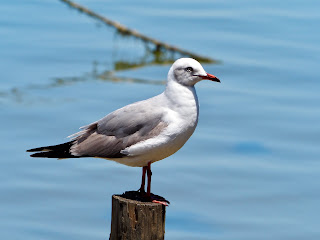Thursday 21st November 2024: S. Africa Day 4, Langebaan to Ceres
My first bird of the day was a Rock Martin, which flew around the hotel grounds as we loaded the bus, then settled on a small ledge for several minutes - until Tim got his camera out for a photo! Next we stopped to check on the Verraux’s Eagle Owls, but there was no sign of them hunting the area, so we did not linger. A Familar Chat on one of the buildings offered some small compensation.
We drove a short distance to a nearby area of scrubland, where we quickly found Karoo Lark, Karoo Scrub Robin, with distinctive white tips to its tail, and of course, the ubiquitous Grey-backed Cisticola. A Grey Tit was spotted lurking in a small bush, but skulked in the middle, reluctant to show itself properly. However, we saw enough to be able to add this to our ever growing list. A distant Rock Kestrel was viewed through the scope.
After this we set off through agricultural fields to search for larks, and encountered our first Blue Cranes, the national bird of South Africa, and very elegant they were too. We were thrilled to observe one displaying to its partner in a graceful dance.
 |
| Blue Crane |
We broke our journey at a roadside cafe, where Black-winged Kites nested in trees across the road. Whilst watched these, a Bar-throated Apalis called from the bush in front of us, and in response to phishing, came to the top just a few feet away. A local birder tipped our guide off to a Spotted Eagle Owl nesting in a rocky outcrop behind the cafe, and we soon found both an adult and young bird roosting here, giving incredible close views, a photographer’s treat. In a nearby bush a Chestnut-vented Warbler burst into song, gradually moving up and flying between bushes, enabling some good views of this colouful bird. Finally, we paused the bus by a nestbox and were able to make out the facial features of a Barn Owl roosting inside. It had been a very productive stop!
 |
| Bar-throated Apalis (Stephen Hawkins) |
 |
| Spotted Eagle Owl |
 |
| Chestnut-vented Warbler (Stephen Hawkins) |
Continuing our drive through the area we found Sickle Winged Chats on the fenceline, then striking Capped Wheatears. We stopped again to search for the endemic Long-billed Lark, a large, long-legged species, and eventually located a bird stood on a low mound across the road. It gradually wandered closer, and we were treated to superb looping display flights, a real wow moment, reminding us of the splendid Hoopoe Lark from Morocco. Red-capped and Large-billed Larks were also found here, together with a rather unmemorable Karoo Chat.
 |
| Capped Wheatear |
 |
| Cape Long-billed Lark |
Our next stop was at the Berg River estuary, where we had great views of a pair of Pied Kingfishers. Amongst the regular Hartlaub’s Gulls, we picked out a few Grey-headed Gulls, showing pale eyes, some with a faint hint of the grey head. Huge Kelp Gulls were also loafing here. Little Swifts nested close to the road, and these and White-throated Swallows filled the air. A Pin-tailed Whydah landed on a nearby telegraph wire, then an African Darter flew in and landed across the river, where it sunned itself on the muddy bank.
 |
| Pied Kingfisher |
 |
| Grey-headed Gull |
A short drive to some nearby salt pans, produced yet more birds, with both White-faced and Kitlitz’s Plovers feeding at the water edges. A Chestnut-banded Plover and Common Sandpiper were both new for the trip. Elsewhere, Little Stints and Curlew Sandpipers fed at the margins, and on the pools Black-necked Grebe, Cape Teal and African Shelduck were all found. Banded Martins soared overhead.
 |
| Chestnut-banded Plover |
Our next stop was by a bridge over a small river in the midst of a dry floodplain. Around half a dozen Red Bishops perched on swaying reeds over the water, and a single Eurasian Bee-eater flew past calling. In the distance, a group of White Pelicans were kettling and a small group of Glossy Ibis passed over, long necks outstretched. Suddenly, and to the excitement of Andy, our guide, a huge Goliath Heron flew over in front of the bus, just as we were about to leave this location.
We continued on to a small sewage works where birds were plentiful. White-faced Whistling Ducks were trip ticks here, as was a Water Thick- Knee, with distinctive wing bar. Other birds seen here included Three-banded and Kittlitz’s Plover, Reed Cormorant, Cape and Red-capped Teal, Yellow-billed Duck, Grey Heron, Blacksmith Plover and Sacred Ibis, making for a very productive location. Then, as we drove away, we spotted an African Hoopoe in the road.
At Michels pass, en route to our next accommodation, we had some great views of a pair of Verraux’s Eagles soaring over the towering cliffs, their wing markings and tail bands clearly visible. These were soon mobbed by a Booted Eagle and white-necked Raven, but were undeterred and continued to entertain us for some minutes.
Finally, as we approached the Riverside Lodge at Ceres, a pair of Black Ducks were found dabbling in the vegetation on a small river. A great end to a superb day’s birding.
 |
| Black Duck |



Comments